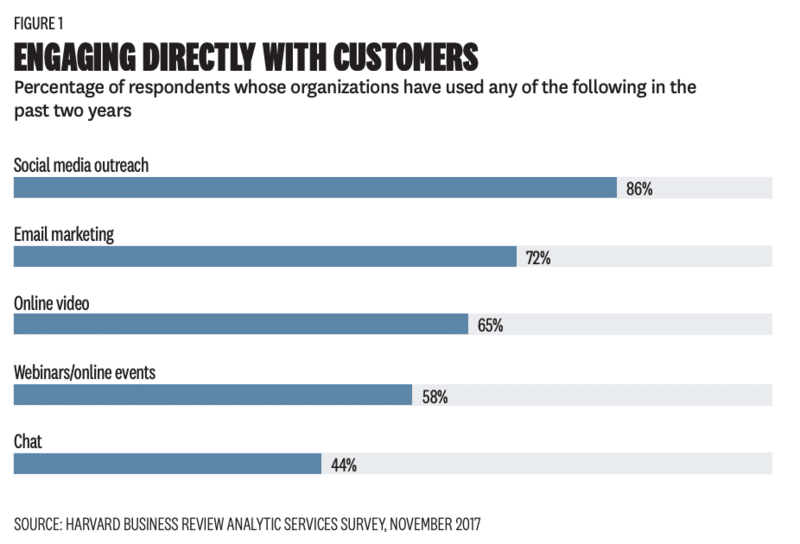It used to be that the customer was the revered and beloved king (or queen).
Now, the customer is an omniscient and demanding dictator, who wants everything in a snap and instills fear in businesses everywhere. To appease this customer, you need a strategy for rock solid customer experience.
And the smallest denominator of every customer experience? A customer interaction.
Before you settle down with this quick primer, let’s be clear on one thing: it’s ultra-expensive to ignore customer experience (CX).
Everybody knows that customer experience is a key differentiator, but the statistics are still eye-widening.
According to Dimension Data’s Global CX Benchmarking Report (2017), 81% of organizations cite CX as a competitive differentiator, reporting a 92% increase in customer loyalty, an 84% uplift in revenue, and 79% savings in dollar cost.1 And if you’re in the auto manufacturing industry, improving your CX by one point can lead to more than $1B in additional revenue!2
And that’s not all. In a different study, companies that prioritized and managed CX effectively were three times as likely to have exceeded their top business goals in 2019.3
On the other hand, poor customer service will cost you dearly. Businesses lose to the tune of a whopping $75 billion just by ignoring CX.4 (And this is an ever-increasing figure.)
As things are, nailing CX is harder than it ever was in the history of business. In the age of instant gratification and omnichannel customer service, patience is shrinking while customer expectations are skyrocketing. Businesses like yours simply can’t afford to drop the ball. So how do we do this?
Through efficient, empathetic, and proactive customer interactions.
In this article, we’ll cover:
- The basics of customer interactions
- Why bother caring about customer interactions?
- 8 best practices that’ll transform your customer interactions
How customer-obsessed is your business? Take the quiz. 💚
What are customer interactions?
Every time a customer communicates with a company, it’s a customer interaction.
Yes, every single time. Not just when the customer has a problem.
These can be direct or indirect, human-to-human or not.

Image from Customer Interaction | https://hbr.org/resources/pdfs/comm/on24/ScalingHumanInteractionInCustomerExperience.pdf
Customer interactions occur across multiple channels: face-to-face, in a webinar, on social media, websites, chatbots, customer surveys, email, you name it.
Even when your customer encounters your brand unintentionally (like when you’re acing proactive customer service by reaching out to your customers first), they’re still technically interacting with it.
This includes website visits. Your app. The DMs of your social media profiles. Also when:
- You’re onboarding them.
- You’re sending them a customer feedback survey.
- They’re on your website’s self-help section.
… And heaps more.
Different types of customer interactions
Human-to-human customer interactions
Some interactions are human–to-human, such as when a customer talks to a sales representative in the aisle of a brick-and-mortar store or speaks to an agent at an inbound call center.
Automated/non-human customer interactions
It’s said that AI will power 95% of all customer interactions by 2025,5 both in the customer-facing space—through chatbots like Solvemate or product recommenders like the ones you see on an e-commerce store’s “Products You Might Like” section—and also behind the scenes.
The sum total of all these customer interactions forms your customer experience.
Customer service and CX are not interchangeable terms, though they’re related. Customer service is responsible for retaining and extending customer relationships once a product or service is sold, while CX is the sum of all the interactions a customer has with a company. For a more detailed breakdown, read this.
How can customer interactions benefit your business?
Let’s reframe this a bit: how can positive customer interactions benefit your business, and how can negative customer interactions hurt your business?
Positive customer service

Great customer interactions are efficient and empathetic. They build trust, communicate dependability, and assure customers they’ve made the right choice by selecting you to fulfill their needs and desires.
When an executive’s presentation software conks out on the Friday before a virtual all-hands meeting on Monday, and the service center fixes it in less than 24 hours over the weekend, it’s fabulous CX.
Positive customer interactions are the bedrock of great brands, paving a lovely yellow brick road to loyalty.
It makes customers feel special. It makes them want to come back to you, recommend you to their friends and family, and tell everyone they know about how wonderful you are.
[ebook-download title=”How customer-obsessed is your business?” link=”https://netstorage.ringcentral.com/documents/quiz_how_customer_obsessed_your_business.pdf” cta-text=”Take the quiz” src=””]
Negative customer interactions
These are easy to think of, because they’re memorable.6 And they are serious must-avoids.
An unduly long wait at the checkout counter. A 10-minute hold on the toll-free helpline (which doesn’t offer the language of your choice). The sales rep who has no idea whether there’s any stock for your laptop charger and needs to duck back to the store to check—where they disappear for 20 minutes. But when they emerge, they ask you to visit another store in another locality. And you’re already running late.

Poor customer interactions are sloppy, inefficient, inconsistent, and slow. According to research by the Miller Heiman group, 93% of customers will defect from a business after fewer than three bad experiences, and more than 1/3 report posting their dissatisfaction on social media.7 A dissatisfied customer is a potential fire to put out.
Why you need to prioritize customer interactions
Imagine you’re at a water dispenser and you want to fill a bottle by pouring water through a funnel into it. The funnel has tons of holes. Which of the two options do you think will get the job done more efficiently?
- A) Plugging the leaks in the funnel
- B) Increasing the pressure of the water flow
It’s a no-brainer. Plugging the leaks, right? Now think of option A as fixing your customer interactions and option B as ramping up your sales and marketing to attract new customers. Which, by the way, will cost you five times as much.8
If you build a reputation for poor service, nobody is going to want to come to your brand, no matter how awesome (and expensive) your marketing strategy is.
8 best practices when interacting with customers
Making the shift to a customer-centric strategy is challenging if you’ve never framed your business that way before. There’s no results-guaranteeing playbook—but there are best practices.
If you have the budget to hire a customer experience leader to guide your overall strategy, do it. Otherwise, listen to your customers and ground your strategy in the following pillars:
1. Meet customers on their channel of choice
Customers have dozens of ways to reach out to you and want to do so on demand. Each customer is different. Millennials and Gen Z are digital natives and lovers of Instagram and Tik Tok. Boomers tend to prefer Facebook and phone calls. Tailor your messaging for each channel and audience.
Don’t create friction for your customers by lobbing them from one channel to another. If you see a question in your Facebook DMs, act on it there and then, instead of asking your customer to, say, call a helpline instead.
Make sure you’re able to respond instantly. Customers are often strapped for time and don’t like to wait.
Have a strategy in place and the tools to do this. Check out communication apps (like RingCentral Engage Digital™) that let you talk to them on the channels of their choice:
2. Personalize interactions
Customers want to be heard. They want to feel important, like the only customer in the world.
Research shows 80% of consumers are more likely to make a purchase when brands offer personalized experiences.9
When a frazzled stay-at-home dad calls the bakery to place a last-minute order for his child’s birthday cake, and the baker remembers his child’s name and hazelnut intolerance, it makes a great impression—and maybe an anniversary cake order a month down the road.
3. Streamline your tools
Customers want their experience with your business to sync with their life and won’t hesitate to drop you if your interactions don’t match up. Yet, the reality is that businesses and teams are always in flux.
To manage skyrocketing customer expectations and ever-shifting teams, you need the right tools (read: cloud communications technology).
Cloud technology is no longer just a trendy nice-to-have; you could argue that it’s necessary for collaboration-driven teams to be productive. Not only is it super-secure, it also provides you with the flexibility and the horsepower you need to handle customer interactions across different channels and even geographic locations. While choosing what tools to use, remember that tools too, can be siloed—and avoid this at all costs. It’s inefficient.
When tools are siloed, your team has to toggle between them and update information in each app by hand as they’re solving issues. This can be a serious drain on efficiency and makes for a protracted, frustrating process for both customer and agent.
Ultimately, this could lead to an increase in customer wait times, or require an increase in your team count to keep wait times low. This would be disastrous in a field as competitive as CX. Instead:
- Use modern contact center technology with omnichannel capabilities, and don’t skimp on integrations with CRMs, data like customer experience analytics, automation, coaching, and more.
- Make sure the tech you choose includes the ability to share information and support capabilities so customers don’t need to pursue further follow-ups via email, web, or other channels.
4. Have a customer experience roadmap
Think of the journey your customer takes from the point they recognize that they need to contact you to the point you respond.
For Harvard Business Review’s May-June 2019 issue,10 Nicolaj Siggelkow and Christian Terwiesch outline three typical stages that you could use as a starting point: “… recognize, when the customer becomes aware of a need; request, when he or she identifies a product or service that would satisfy this need and turns to a company to meet it; and respond, when the customer experiences how the company delivers the product or service.”
Your customer experience cycle might look different. Map out every touchpoint a customer could have with your organization and then assign responsibilities to individuals in your team for making sure these touch points or defining moments are positive.
5. Train your team
Provide everyone on your team with training in the essential customer service skills. Standardize your practices and bring them up to speed on your products and services.
Empower them to make decisions independently and connect with others in your business easily when they need to. All this comes down to collaboration, which brings us to our next point:
6. Improve collaboration among sales, marketing and customer teams
When a frustrated customer calls up the toll-free hotline, they don’t care if their request is actually better answered by a different department. They don’t want to bounce around different numbers or make numerous trips to your physical location to resolve something. They’re in a hurry. Wherever they might be in their journey, they want their contact with you to be simple and efficient.
But for whatever logistical and other reasons, most businesses’ internal systems aren’t primed for making this easy.
In a standard on-premises solution, customer service teams operate physically separately from the rest of the business and in many cases, they don’t have a quick way to request help from other team members (like engineers and product knowledge experts) without putting a customer on hold.
The best way to handle this? Knock down the silos . Improve communication between different teams and find a way to bring everyone on the same page, irrespective of their location. Go flat. (The cloud tools mentioned in point 3 can help.)
7. Improve employee engagement
Customer-facing work is stressful and customer service jobs have among the highest attrition rates in the world.11 Make work enjoyable and meaningful for your customer-facing employees by investing in employee engagement .
Employee engagement is like a superfood that nourishes every area of your business. It has benefits at so many levels and is worth every ounce of effort you spend on it: it can improve productivity, help you keep your employees around longer, and boost customer satisfaction.12
Customer experience is lost without it. If your employees aren’t happy and enthusiastic at work, they won’t be able to communicate the same qualities to your customers.
8. Keep it consistent
Whether you’re responding to a complaint tweet or a comment on an Instagram picture with an order issue, treat those communications with the same care as you would a more traditional phone call. Every chat a customer has with you via social media DMs or the phone adds flesh and bones to their idea of who your brand is and what it stands for.
Customer interactions are to branding what touch is to the five senses. They can make or break your brand, so keep things consistent with the following tips:
- Maintain the same tone of voice (whether it’s formal, quirky, casual, etc.) across your communications across social media, phone, email and SMS text messaging.
- When customers interact with brands on Twitter or Facebook, they want that same context carried forward to inform future conversations they have on other channels so they don’t constantly need to bring you up to speed. Maintain a smooth flow of data so agents can pick up where they left off on any platform.
Start improving your customer interactions today
If you’ve never really given too much thought to your customer experience, it can seem a little overwhelming, and—gulp—expensive.
But it doesn’t have to be.
Sure, investing in customer service apps can make a huge difference to your efficiency, but whether you’re interacting over Facebook or video call, customer interactions eventually boil down to two traits that anybody can nurture: good old human connection and a genuine desire to help your customers.
3 cmo.adobe.com/articles/2020/2/digital-trends-study–2020-is-the-year-of-cx-centric-business-tr.html
5 financedigest.com/ai-will-power-95-of-customer-interactions-by-2025.html
6 marketingcharts.com/digital-28628
7 millerheimangroup.com/resources/blog/how-to-make-every-customer-interaction-count/
9 slideshare.net/EpsilonMktg/the-power-of-me-the-impact-of-personalization-on-marketing-performance/1
10 hbr.org/2019/05/the-age-of-continuous-connection
11 hbr.org/2018/11/reinventing-customer-service
Originally published Mar 31, 2020, updated Oct 10, 2023





